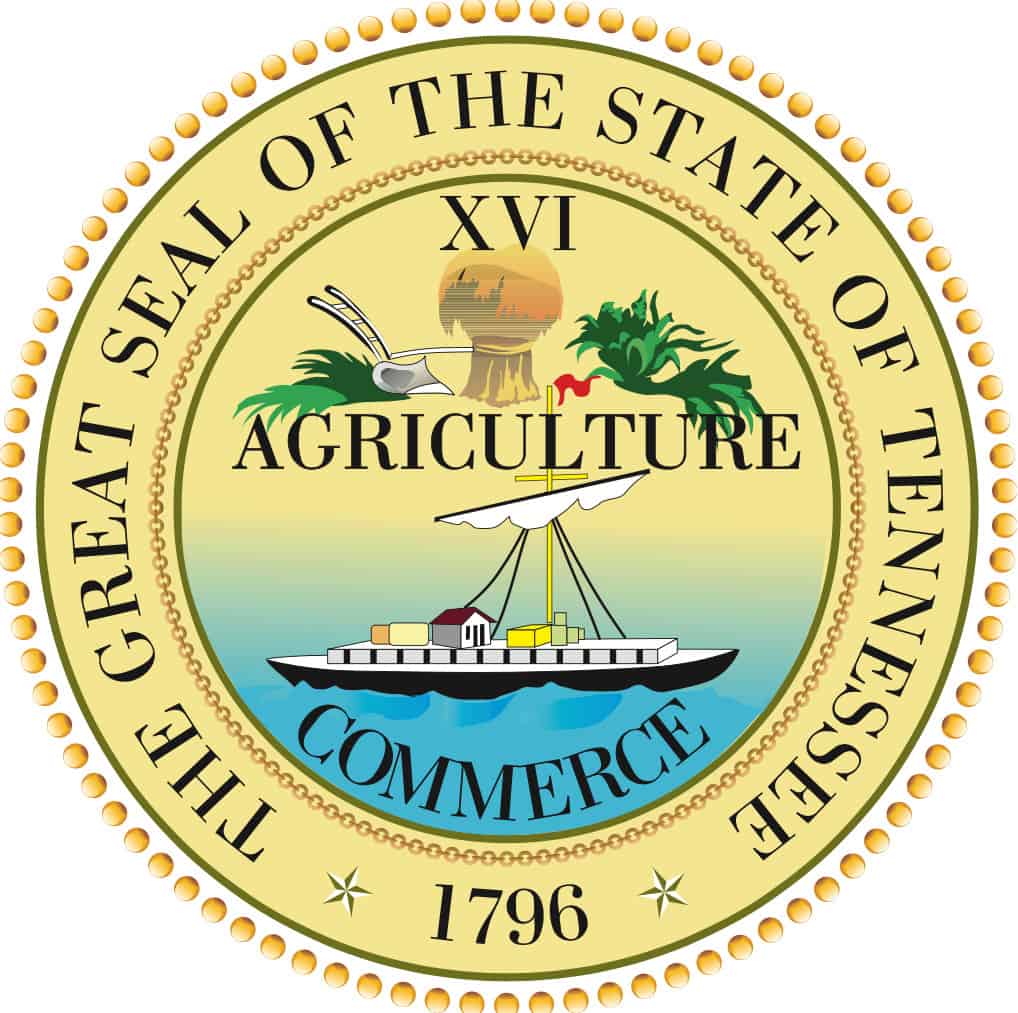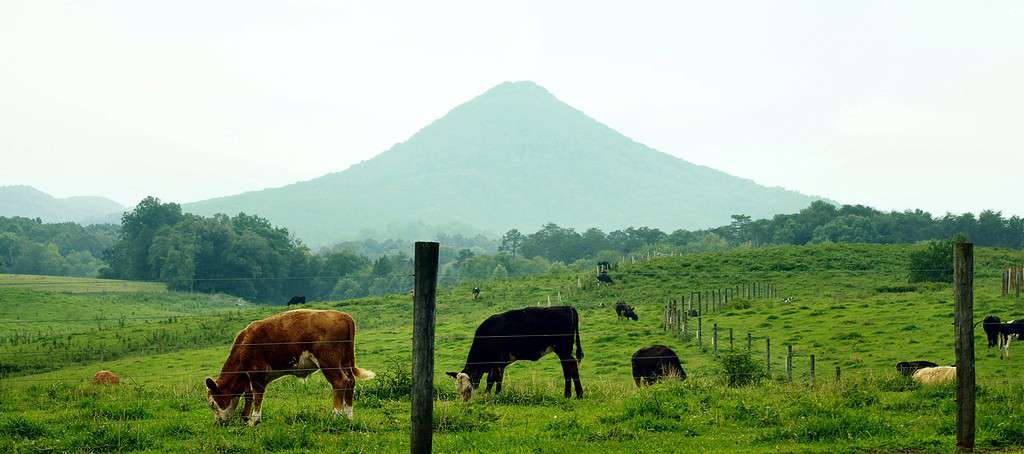The admission of Tennessee to the Union as the sixteenth state took place in 1796. The Constitution of 1796 required the creation of an official state seal. The document states, “There shall be a seal of this state, which shall be kept by the governor, and used by him officially, and shall be called ‘The Great Seal of the State of Tennessee.'” (Constitution of 1796, Article II, Section 15) Subsequent constitutions in 1835 and 1870 kept the provision verbatim. Here is the history and meaning behind The Great Seal of the State of Tennessee.

The Great Seal of the State of Tennessee highlights the centrality of agriculture and river commerce in the state.
©Alexander Zavadsky/Shutterstock.com
History
Though the state’s first constitution required the creation of a state seal in 1796, it would be five years later before any action would be taken. Finally, on September 25, 1801, committees from both the Senate and House of Representatives were assembled to create the official seal of Tennessee. One committee was tasked with the seal’s design. Another was appointed to find a contractor who could cut the seal and design the press.
Design and Manufacture of the Seal
The design committee created a circular seal with the words “THE GREAT SEAL OF THE STATE OF TENNESSEE” around the circumference. The date “Feb. 6th, 1796” in the lower portion of the circle reflects the adoption date of the state’s constitution. The Roman numeral “XVI” in the upper part of the circle attests to Tennessee’s status as the sixteenth state in the United States.
The words “AGRICULTURE” and “COMMERCE” appeared inside the circle, reflecting two of the state’s major economic drivers. Images of a plow, sheaf of wheat, and cotton plant accompanied “AGRICULTURE” while a boat and boatman were included with “COMMERCE.” The words “AGRICULTURE” and “COMMERCE” appeared inside the circle, reflecting two of the state’s major economic drivers. Images of a plow, sheaf of wheat, and cotton plant accompanied “AGRICULTURE,” while a boat and boatman were included with “COMMERCE.”
The second committee contracted with William and Matthew Atkinson to cut the seal and design the press.
Seven months after these committees were organized, the official seal was delivered to Governor Archibald Roane. The seal and press were first used on April 24, 1802, on a document ordering payment to the Atkinsons for manufacturing them.

The sheaf of wheat on Tennessee’s state seal highlights the importance of agriculture in the state’s economy and culture.
©iStock.com/IakovKalinin
Changes to the Seal
The seal remained unchanged until 1829. A new seal design appears on documents from the time period, although there are no known records authorizing a change to the seal. On this new seal, “Feb. 6” is absent, leaving just the year of the ratification of Tennessee’s constitution, 1796. The current state seal mirrors that change. The boat’s design is also different on this new seal, facing in the opposite direction. This new seal remained in use until the 1860s.
Slight variations appear in various seals from that time period, but the seal currently in use today was first seen on state documents in 1869. To eliminate the variances that had plagued the seal in the past, the current seal was officially adopted in 1987 by the 95th General Assembly, Public Chapter 402.
Symbolism
The original designers of The Great Seal of the State of Tennessee recognized the importance of two of the state’s primary economic engines.
Agriculture
The word “AGRICULTURE” honors the importance of farming throughout the state. With its rich soil and annual rainfall (it is the sixth rainiest state in the U.S.), Tennessee abounds with agricultural opportunities. Large fields of corn, hay, and cotton abound in the flatlands of western Tennessee. Orchards and vegetable farms proliferate in the middle of the state. Cattle farms and other livestock operations occupy the mountains of eastern Tennessee. The word “AGRICULTURE” honors the importance of farming throughout the state. With its rich soil and annual rainfall (it is the sixth rainiest state in the U.S.), Tennessee abounds with agricultural opportunities. Large fields of corn, hay, and cotton abound in the flatlands of western Tennessee. Orchards and vegetable farms proliferate in the middle of the state. Cattle farms and other livestock operations occupy the mountains of eastern Tennessee.
The images of the plow, sheaf of wheat, and cotton plant on the state’s seal reflect the importance that agriculture has, and continues to play in the state.

Livestock operations abound in the mountains of east Tennessee, such as this cattle farm in Knox County.
River Commerce
A riverboat also appears on the seal, along with the word “COMMERCE.” Unfortunately, the boatman from the original seal does not appear in the seal’s multiple redesigns, but the boat remained.
There are 60,417 miles of rivers, streams, and creeks in Tennessee, including three major rivers: the Mississippi, Cumberland, and Tennessee. These rivers are vital shipping routes, so those early Tennessee legislators included a riverboat on the original seal. The boat remains on the seal today, reflecting the importance of river commerce in the Volunteer State.

The Cumberland River is one of Tennessee’s major river shipping routes, seen here in Nashville.
©Sean Pavone/Shutterstock.com
A New Addition to Tennessee’s Seal?
Two Tennessee legislators filed companion bills proposing a change to the state seal in January 2023. The bills introduced by Representative John Holsclaw (R—Elizabethton) and Senator Rusty Crowe (R—Johnson City) would add the words “In God, We Trust” to the official state seal.” Companion bills proposing a change to the state seal were filed by two Tennessee legislators in January 2023. The bills introduced by Representative John Holsclaw (R—Elizabethton) and Senator Rusty Crowe (R—Johnson City) would add the words “In God, We Trust” to the official state seal.
The Senate passed its bill unanimously. The House’s bill also passed by a vote of 74-18. The bills would require the governor to submit a design that includes the four new words by July 1, 2025. Lawmakers would need to approve the design before it would become the new state seal.
“In God, We Trust” is the national motto of the United States, established on July 30, 1956, when President Dwight D. Eisenhower signed the legislation. The phrase first appeared on coins in the United States in 1864. It also appears on the official state seals of Florida and Mississippi. “In God, We Trust” is the national motto of the United States, established on July 30, 1956, when President Dwight D. Eisenhower signed the legislation. The phrase first appeared on coins in the United States in 1864. It also appears on the official state seals of Florida and Mississippi.
Thank you for reading! Have some feedback for us? Contact the AZ Animals editorial team.







